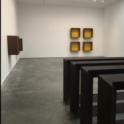Minimalism, Appropriation and the Public Domain
I’m probably going to get called an asshole for writing this, or maybe sarcastic. If I’m lucky I’ll be called both.
I’ve taken it upon myself to turn a new leaf. Starting this week I’m making it a point to see more art in person. To be honest I have dreaded doing this for the last, say, 15 years. It’s not so much laziness or my predilection for viewing images authored by monkeys. It boils down to the simple fact that 99% of the stuff out there is positively not worth a subway ride. Truth be told I’d rather look at and read about ’60s and ’70s art, particularly conceptual and minimalist art. And when the writings are from the October group, that much the better.
With that aside, let me say that last week I walked over to David Zwirner gallery on 20th Street (in NYC, of course), to see Donald Judd’s Cor-ten steel sculptures from the late ’80s and early ’90s. I’m not really writing much on Judd here, primarily because there’s already so much better stuff out there, but also because the other two exhibitions I viewed (and which I did not plan on viewing) lend themselves more to the subject matter of this blog. Let me just say that if you’re in NYC between now and December 19th and you don’t see this show, you’re simply lacking in cultural sophistication.
That aside, I had some extra time and decided to see the Jeff Koons and Jim Shaw exhibitions (both also in NYC). The Koons, well, let’s just say it’s Koons. They’re not particularly mind-blowing, but after seeing Judd’s work they reminded me of the main criticism against Minimalism; that Minimalism’s claim to self-referentiality was more a dream than reality. In the new Koons works the blue reflective “crystal” balls make this quite evident, particularly when you view the wall works as invoking the issues and questions usually reserved for sculpture. The architecture and site as well as the role of the viewer are clearly highlighted. I could not help but wonder why Koons had opted against recreating Velazquez’s painting, Las Meninas, which would have been more than apropos for this exhibition.
But the most interesting aspect in the Koons exhibition came as I exited the Gagosian gallery. It’s not a major confession of sorts, but when it comes from one of appropriation art’s seminal leaders, it has particular significance. I’m not necessarily calling the guy a hypocrite, but I’m certain Koons can afford good lawyers who would advise him–and Gagosian–of the pros and cons of using copyright accreditation language (and doing it properly). Not sure what exactly Koons or Gagosian are claiming copyright to here. The artwork list? The artworks? The gallery? All of the above? Comical indeed.
One last note, and please correct me if I’m wrong. In this recent exhibition, is Koons using images solely from the public domain (under U.S. law)?
Page 1 of 2 | Next page

